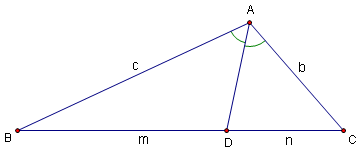Angle Bisector Theorem
Introduction
The Angle Bisector Theorem states that given triangle ![]() and angle bisector AD, where D is on side BC, then
and angle bisector AD, where D is on side BC, then ![]() . Likewise, the converse of this theorem holds as well.
. Likewise, the converse of this theorem holds as well.

Proof
Method 1
Because of the ratios and equal angles in the theorem, we think of similar triangles. There are not any similar triangles in the figure as it now stands, however. So, we think to draw in a carefully chosen line or two. Extending AD until it hits the line through C parallel to AB does just the trick as we shall see!
Since AB and CE are parallel, we know that $\angle BAE \eq \angle CEA$ (Error compiling LaTeX. Unknown error_msg) and $\angle BCE \eq \angle ABC$ (Error compiling LaTeX. Unknown error_msg). Triangle ACE is isosceles, meaning that AC = CE.
By AA, ![]() . By the properties of similar triangles, we arrive at our desired result:
. By the properties of similar triangles, we arrive at our desired result:
Method 2
Let ![]() . Now, we can express the area of triangle ABD in two ways:
. Now, we can express the area of triangle ABD in two ways:
Thus, ![]() .
.
Likewise, triangle ACD can be expressed in two different ways:
Thus, ![]() .
.
But ![]() and
and ![]() since
since ![]() . Therefore, we can substitute back into our previous equation to get
. Therefore, we can substitute back into our previous equation to get ![]() .
.
We conclude that ![]() , which was what we wanted.
, which was what we wanted.
In both cases, if we reverse all the steps, we see that everything still holds and thus the converse holds.
Examples
- Let ABC be a triangle with angle bisector AD with D on line segment BC. If
 and
and  , find AB and AC.
, find AB and AC.
Solution: By the angle bisector theorem, or
or  . Plugging this into
. Plugging this into  and solving for AC gives
and solving for AC gives  . We can plug this back in to find
. We can plug this back in to find  .
. - In triangle ABC, let P be a point on BC and let
 . Find the value of
. Find the value of  .
.
Solution: First, we notice that . Thus, AP is the angle bisector of angle A, making our answer 0.
. Thus, AP is the angle bisector of angle A, making our answer 0.









